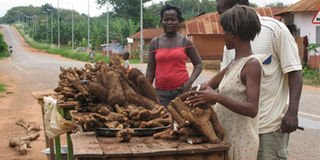Prime
Scientists link up to introduce West African yams in Uganda

Yams are grown in many parts of Africa for food and can be prepared in several forms.
What you need to know:
Yams are an important source of food for many people in Africa, especially West Africa. Under an international collaboration, Ugandan scientists are finding out how well yams from West Africa can gorw under local conditions, writes Lominda Afedraru
Farmers specialising in growing yams which is a fixture on the Ugandan food menu, both in eating places and in homes in various areas around the country, will soon benefit from the importation of West African yams that scientists are testing to see if they can grow well in the soils here.
Dr Leena Tripathi, a scientist working with the International Institute of Tropical Agriculture (Iita), with its headquarters in Nigeria, has been training two Ugandan scientists for the last two years. This training was conducted at the National Agricultural Research Laboratories Institute in Kawanda, on how the yam variety from Nigeria can be grown on Ugandan soil through multiplication of its seedlings using tissue culture.
Tissue culture is one of biotechnology tools that used in propagating plants. It is the cultivation of plant cells, tissues, or organs on specially formulated nutrient media.
According to Dr Tripathi, most farmers in Africa grow yams using its tuber, which in most cases is infested with pests and diseases, thereby producing poor yields.
She says propagating yams using tissue culture is a good practice because at the end of it all, a famer is able is come up with clean material that is free of pests and disease infection.
Two years ago, Iita provided a small grant to Dr Leena and her team to propagate varieties of yams from Nigeria using tissue culture.
What the team has done at laboratory level is pick part of the imported plant and develop it using this method.
This exercise takes them about three months before it is transferred to the screen house for a further growth stage. By the time it is ready to be transferred to field trial, it would have taken nine months for the seedlings to be ready.
Dr Leena does not intend to advance the research to farmer’s fields due to limited resources but she is happy that they have come up with scientific data indicating that yams from West Africa can be grown on the Ugandan soils.
“African yams are usually infested by nematodes and other fungal diseases but I am happy that I have trained two Ugandan students on how to propagate yams using tissue culture and farmers who are interested in using this method can approach these students for propagation purposes,” Dr Leena said.
Mr Tony Tazuba, one of the students pursuing his Masters degree in biotechnology, majoring in breeding yams using tissue culture, says they have so far regenerated the crop and have come up with seven species.
However the team has specialised in two varieties called Dioscorea rotundata and Diocorea alata, which are the perennial creeping type of yams that are majorly produced in Nigeria.
“Yams take about nine months to grow and most African farmers use its tuber as food, but here we are using its leaves to find the optimum condition for them to grow which we have actually ascertained. We came up with 28 different types but we are now shorting out which ones can grow within the shortest period of time,” Mr Tazuba explained.
He is of a different view that since the plants are currently at the screen house to see its transformation process, they will definitely be taken to field trials for further growth evaluation process.
Dr Nelson Wanyera, a yam breeder currently working at National Semi-Arid Resources Institute (Nasarri) at Serere in Soroti says that yams grown by East African farmers and those grown by West African farmers have differences.
Most farmers who deal in growing yams in East Africa including Uganda use its tubers for multiplication and it is mostly grown in the Lake Victoria basin where there is a lot of rainfall, as well as mountainous areas such as western Uganda, Mbale and Adjumani.
Yams, according to Dr Wanyera, are multi-species crop that are both climbing plants as well upright growing crops. While yams in West Africa are white in colour, those in East Africa are of the yellow variety.
In Tanzania, they are grown mostly in Bukoba and in Kenya, in parts of Meru and Kiambu.
Another type of yams in East Africa are water yams that are grown in the Buganda region as well as Adjumani. Coco yams are those grown mostly in valleys.
According to Dr Wanyera, the yam variety mostly consumed in Uganda is called Kyetumula in Luganda. Others are Balugu and Endagu varieties.
He adds that many farmers in Uganda do not know how to grow yams but under a project that was funded by Iita, which run from 1998 to 2001, he had the chance of educating many farmers in the country on the importance of growing yams and management methods of how to grow it.
He says the crop is medicinal because its steroid extract is used for making family planning pill tablets and for the men in Africa it acts as a “natural Viagra”.
Despite their low social status in the food kingdom and “bad” looks, yams are valuable sources of nutritional value. Yams are a rich source of vitamin B6, which is a vitamin that is useful in reducing the risk of heart disease. They are also laden with potassium, which is helpful in controlling blood pressure.
Yams also come with a good mix of dietary fibre which slows down the absorption of sugars from the digestive system in to the blood stream. By so doing fibres from yams help in controlling blood sugar levels.
Quick facts on yams in Uganda
Where are Ugandan yams mostly grown?
Most Ugandan yam varities are grown in the Lake Victoria basin and in mountainous parts of the country such as Mbale in eastern Uganda, mountainous parts of western Uganda and Adjumani in northern Uganda
Under what conditions does it grow?
Yams grow well in areas where there is a lot of rainfall, in valleys and under coffee plantations where too much sunshine is prevented from destroying the crop.
How long does it take to grow?
Experts in yam breeding say that the crop takes nine months to grow. However those that are propagated using biotechnology mechanisms as well as tissue culture may take shorter time depending on the soil nutrient of the place as well as humidity of where it is grown.
How big is the yam market in Uganda?
In his view, Dr Wanyera says yams have huge market in Uganda because it has become a common item on the menus even in the international hotels in Kampala, Jinja and other major towns in the country and it is known as one of the commonly consumed local food.
However the consumer awareness of the consumption of yams has for a long time been marginalised during times when there is plenty of food but 90% of yam production and consumption takes place in West Africa especially Nigeria. Today, a collection of relatively small tubers goes at Shs2,000 in the local markets.




